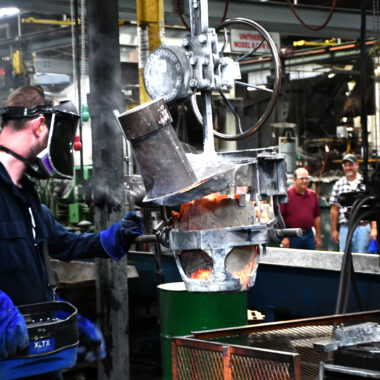Mastering Aluminum Casting: Proven Methods to Boost Manufacturing Effectiveness
Mastering Aluminum Casting: Proven Methods to Boost Manufacturing Effectiveness
Blog Article
Dive Into the Globe of Aluminum Casting: Recognizing the Various Techniques
Aluminum spreading is a basic procedure in the production market, with different methods used to produce complex and specific parts. From the standard sand casting method to the advanced die spreading procedure, each approach uses distinct benefits depending on the needs of the task.
Sand Spreading Technique
Sand casting, a widely-used method in light weight aluminum casting procedures, entails developing mold and mildews made of compressed sand for pouring liquified steel. Once the mold is prepared, it is firmly positioned in a flask and molten aluminum is poured into the dental caries.
After the steel has actually cooled and strengthened, the sand mold is escaped to reveal the aluminum casting. Sand casting permits for the manufacturing of complex shapes and big parts that may be challenging or costly to produce making use of other techniques. It is additionally a lasting technique as the sand can be recycled and used numerous times, minimizing waste in the spreading process.
Irreversible Mold Strategy

One considerable advantage of the Long-term Mold Method is the improved dimensional accuracy it supplies. The steel mold allows for tighter resistances and finer details in the last light weight aluminum castings compared to sand spreading approaches. This accuracy makes it a preferred option for applications where tight dimensional control is critical, such as in the automobile and aerospace sectors.

Die Casting Process

Financial Investment Casting Approach
Utilizing a precision casting technique, Financial investment Casting Strategy includes creating detailed aluminum elements by putting liquified metal into a ceramic mold and mildew. This procedure, likewise called lost-wax spreading, starts with the production of a wax pattern of the desired part. This wax pattern is then coated with a ceramic material to create a covering. When the ceramic shell is set, it is heated up to remove the wax, leaving behind a hollow ceramic mold and mildew.
Financial investment casting is typically utilized for manufacturing elements in sectors where elaborate styles and limited tolerances are called for, such as aerospace, auto, and clinical devices. The versatility and Web Site precision of the Investment Casting Approach make it a beneficial technique in the world of aluminum spreading.
Lost Foam Casting Method
Having checked out the detailed official website precision of Financial investment Casting Strategy, the emphasis now moves to the ingenious approach of Lost Foam Spreading in light weight aluminum part manufacturing. Lost Foam Casting, also recognized as evaporative pattern casting, is a modern method where a foam pattern of the preferred component is developed and after that coated with a refractory material.
Among the major benefits of Lost Foam Casting is its ability to generate complex shapes with detailed details, usually in a single item without the need for additional machining. This method is additionally understood for its high dimensional precision and smooth surface area coating. Additionally, Lost Foam Spreading is an affordable procedure as it decreases the demand for cores and allows for the manufacturing of lightweight elements. In spite of its benefits, Lost Foam Spreading requires careful control of the casting procedure to protect against problems and ensure top quality elements.
Verdict
To conclude, aluminum spreading offers a range of approaches such as sand spreading, irreversible mold strategy, die casting, financial investment spreading, and lost foam spreading. Each approach has its very own benefits and applications, making aluminum casting a versatile and widely used procedure in different sectors. Recognizing the distinctions in between these techniques is important in picking the most suitable spreading method for details production demands.
Sand spreading, a widely-used technique in aluminum spreading processes, entails producing molds made of compacted sand for pouring molten steel. aluminum casting.The Permanent Mold And Mildew Strategy, like sand spreading, is another common technique utilized in aluminum spreading procedures, providing unique benefits in terms of mold reusability and dimensional precision. The metal mold and mildew permits for tighter resistances and finer information in the last light weight aluminum castings contrasted to sand spreading methods. The 2 main kinds of die spreading are chilly chamber pass away spreading and hot chamber pass away spreading, each ideal for various types of light weight aluminum alloys.In conclusion, light weight aluminum a fantastic read spreading uses a range of techniques such as sand spreading, long-term mold method, pass away spreading, financial investment casting, and lost foam spreading
Report this page